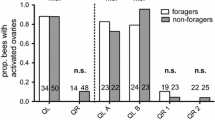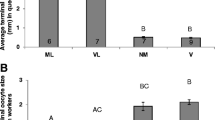Abstract
Though social insect colonies are often considered to be models of cooperative behavior, there can be conflict between queens and their workers over reproduction. In honey bees (Apis mellifera), the queen releases a pheromone that attracts workers and inhibits worker ovary activation such that they remain sterile and rear the offspring of the queen. Furthermore, under queenless conditions, workers can rear new queens from the old queen’s eggs or activate their ovaries and lay their own eggs. Workers vary greatly in their ability to activate their ovaries, and this variation is positively correlated with ovary size. Here, we demonstrate that, compared to their sisters, workers with the larger ovaries are less attracted to queen pheromone, less likely to rear new queens if the old queen is lost, and more likely to activate their ovaries in the absence of a queen. Furthermore, surgically increasing a bee’s ovarian mass reduces her attraction to queen pheromone. The additional ovarian mass altered brain expression levels of the octopamine receptor, Oa1, but these differences did not correlate with response to queen pheromone. Overall, these results indicate that honey bee workers’ response to social cues under both queenright and queenless contexts is modified by their reproductive physiology, such that workers with greater ovary activation rates are less likely to engage in behaviors that promote the queen’s reproduction.




Similar content being viewed by others
References
Allsopp MH, Calis JNM, Boot WJ (2003) Differential feeding of worker larvae affects caste characters in the Cape honeybee, Apis mellifera capensis. Behav Ecol Sociobiol 54:555–561. doi:10.1007/s00265-003-0666-4
Amdam GV, Csondes A, Fondrk MK, Page RE (2006) Complex social behaviour derived from maternal reproductive traits. Nature 439:76–78. doi:10.1038/nature04340
Amdam GV, Page RE, Fondrk MK, Brent CS (2010) Hormone response to bidirectional selection on social behavior. Evol Dev 12:428–436. doi:10.1111/j.1525-142X.2010.00429.x
Barron AB, Oldroyd BP, Ratnieks FLW (2001) Worker reproduction in honey-bees (Apis) and the anarchic syndrome: areview. Behav Ecol Sociobiol 50:199–208. doi:10.1007/s002650100362
Calis JNM, Boot WJ, Allsopp MH, Beekman M (2006) Getting more than a fair share: nutrition of worker larvae related to social parasitism in the Cape honey bee Apis mellifera capensis. Apidologie 37:452–461. doi:10.1051/apido
Erber J, Kloppenburg P, Scheidler A (1993) Neuromodulation by serotonin and octopamine in the honeybee: behaviour, neuroanatomy and electrophysiology. Experientia 49:1073–1083. doi:10.1007/BF01929916
Fussnecker BL, McKenzie AM, Grozinger CM (2013) cGMP modulates responses to queen mandibular pheromone in worker honey bees. J Comp Physiol A Sensory Neural Behav Physiol 197:939–948. doi:10.1007/s00359-011-0654-5.cGMP
Graham AM, Munday MD, Kaftanoglu O et al (2011) Support for the reproductive ground plan hypothesis of social evolution and major QTL for ovary traits of Africanized worker honey bees (Apis mellifera L.). BMC Evol Biol 11:95. doi:10.1186/1471-2148-11-95
Grozinger CM, Robinson GE (2007) Endocrine modulation of a pheromone-responsive gene in the honey bee brain. J Comp Physiol A Neuroethol Sensory Neural Behav Physiol 193:461–470. doi:10.1007/s00359-006-0202-x
Hamilton WD (1964) The genetical evolution of social behaviour. J Theor Biol 7:1–16
Hartfelder K, Bitondi MMG, Santana WC, Simões ZLP (2002) Ecdysteroid titer and reproduction in queens and workers of the honey bee and of a stingless bee: loss of ecdysteroid function at increasing levels of sociality? Insect Biochem Mol Biol 32:211–216. doi:10.1016/S0965-1748(01)00100-X
Hoover SER, Keeling CI, Winston ML, Slessor KN (2003) The effect of queen pheromones on worker honey bee ovary development. Naturwissenschaften 90:477–480. doi:10.1007/s00114-003-0462-z
Hoover SER, Higo HA, Winston ML (2006) Worker honey bee ovary development: seasonal variation and the influence of larval and adult nutrition. J Comp Physiol B Biochem Syst Environ Physiol 176:55–63. doi:10.1007/s00360-005-0032-0
Kamakura M (2011) Royalactin induces queen differentiation in honeybees. Nature 473:478–483. doi:10.1038/nature10093
Katzav-Gozansky T, Boulay R, Soroker V, Hefetz A (2004) Queen-signal modulation of worker pheromonal composition in honeybees. Proc Biol Sci 271:2065–2069. doi:10.1098/rspb.2004.2839
Kocher SD, Grozinger CM (2011) Cooperation, conflict, and the evolution of queen pheromones. J Chem Ecol 37:1263–1275. doi:10.1007/s10886-011-0036-z
Kocher SD, Ayroles JF, Stone EA, Grozinger CM (2010) Individual variation in pheromone response correlates with reproductive traits and brain gene expression in worker honey bees. PLoS One 5, e9116. doi:10.1371/journal.pone.0009116
Laidlaw HH, Page RE (1997) Queen rearing and bee breeding, 1st edn. Wicwas Press, Cheshire, Connecticut
Le Conte YL, Sreng L, Sacher N et al (1994) Chemical recognition of queen cells by honey bee workers Apis mellifera (Hymenoptera: Apidae). Chemoecology 5–6:6–12. doi:10.1007/BF01259967
Le Conte Y, Sreng L, Poitout SH (1995) Brood pheromone con modulate the feeding behavior of Apis Mellifera workers (Hymenoptera: Apidea). J Econ Entomol 8:798–804
Makert GR, Paxton RJ, Hartfelder K (2006) Ovariole number—a predictor of differential reproductive success among worker subfamilies in queenless honeybee (Apis mellifera L.) colonies. Behav Ecol Sociobiol 60:815–825. doi:10.1007/s00265-006-0225-x
Malka O, Shnieor S, Katzav-Gozansky T, Hefetz A (2008) Aggressive reproductive competition among hopelessly queenless honeybee workers triggered by pheromone signaling. Naturwissenschaften 95:553–559. doi:10.1007/s00114-008-0358-z
Melathopoulos AP, Winston ML, Pettis JS, Pankiw T (1996) Effect of queen mandibular pheromone on initiation and maintenance of queen cells in the honey bee (Apis mellifera L.). Can Entomol 128:263–272
Mohammedi A, Paris A, Crauser D, Le Conte Y (1998) Effect of aliphatic esters on ovary development of queenless bees (Apis melliera L.). Naturwissenschaften 85:455–458. doi:10.1007/s001140050531
Moritz RFA, Crewe RM, Hepburn HR (2002) Queen avoidance and mandibular gland secretion of honeybee workers (Apis mellifera L.). Insectes Soc 49:86–91. doi:10.1007/s00040-002-8284-0
Naumann K, Winston ML, Slessor KN et al (1992) Intra-nest transmission of aromatic honey bee queen mandibular gland pheromone components: movement as a unit. Can Entomol 124:917–934
Naumann K, Winston ML, Slessor KN (1993) Movement of honey bee (Apis mellifera L.) queen mandibular gland pheromone in populous and unpopulous colonies. J Insect Behav 6:211–223. doi:10.1007/BF01051505
Oldroyd BP, Beekman M (2008) Effects of selection for honey bee worker reproduction on foraging traits. PLoS Biol 6, e56. doi:10.1371/journal.pbio.0060056
Pankiw T (1997) Queen rearing by high and low queen mandibular pheromone responding worker honey bees (Apis mellifera L). Can Entomol 129:679–690
Paul RK, Takeuchi H, Kubo T (2006) Expression of two ecdysteroid-regulated genes, Broad-Complex and E75, in the brain and ovary of the honeybee (Apis mellifera L.). Zoolog Sci 23:1085–1092. doi:10.2108/zsj.23.1085
Pettis JS, Winston ML, Collins AM (1995) Suppression of queen rearing in European and Africanized honey bees Apis mellifera L. by synthetic queen mandibular gland pheromone. Insectes Soc 121:113–121
Pirk C, Boodhoo C, Human H, Nicolson S (2010) The importance of protein type and protein to carbohydrate ratio for survival and ovarian activation of caged honeybees (Apis mellifera scutellata). Apidologie 41:62–72. doi:10.1051/apido/2009055
Ratnieks FLW, Reeve HK (1992) Conflict in single-queen hymenopteran societies: the structure of conflict and processes that reduce conflict in advanced eusocial species.
Ratnieks FLW, Foster KR, Wenseleers T (2006) Conflict resolution in insect societies. Annu Rev Entomol 51:581–608. doi:10.1146/annurev.ento.51.110104.151003
Roth KM, Beekman M, Allsopp MH et al (2014) Cheating workers with large activated ovaries avoid risky foraging. Behav Ecol 25:668–674. doi:10.1093/beheco/aru043
Seeley TD (1979) Queen substance dispersal by messenger workers in honeybee colonies. Behav Ecol Sociobiol 5:391–415. doi:10.1007/BF00292527
Slessor KN, Kaminski L-A, King GGS, Borden JH, Winston ML (1988) Semiochemical basis of the retinue response to queen honey bees. Nature 332:354–356
Takeuchi H, Paul RK, Matsuzaka E, Kubo T (2007) EcR-A expression in the brain and ovary of the honeybee (Apis mellifera L.). Zoolog Sci 24:596–603. doi:10.2108/zsj.24.596
Tan K, Liu X, Dong S et al (2015) Pheromones affecting ovary activation and ovariole loss in the Asian honey bee Apis cerana. J Insect Physiol 74:25–29. doi:10.1016/j.jinsphys.2015.01.006
Velthuis HHW (1970) Ovarian development in Apis mellifera worker bees. Entomol Exp Appl 13:377–394. doi:10.1007/BF00333492
Vergoz V, McQuillan HJ, Geddes LH et al (2009) Peripheral modulation of worker bee responses to queen mandibular pheromone. Proc Natl Acad Sci U S A 106:20930–20935. doi:10.1073/pnas.0907563106
Wang Y, Kaftanoglu O, Siegel AJ et al (2010) Surgically increased ovarian mass in the honey bee confirms link between reproductive physiology and worker behavior. J Insect Physiol 56:1816–1824. doi:10.1016/j.jinsphys.2010.07.013
Wilson EO (1971) The insect societies. Harvard University Press, Cambridge, Massachusetts
Winston ML (1991) The biology of the honey bee, 1st edn. Harvard University Press
Acknowledgments
We want to thank Dr. Osman Kaftanoglu, Bernardo Niño, and Dr. Elina Lastro Niño for preparing the bee colonies. We would also like to thank Dr. Adam Dolezal for help with ovary dissections.
Conflict of interest
The authors have no competing interests.
Author information
Authors and Affiliations
Corresponding author
Additional information
Communicated by R. F. A. Moritz
Electronic supplementary material
Below is the link to the electronic supplementary material.
ESM 1
(XLSX 9 kb)
Rights and permissions
About this article
Cite this article
Galbraith, D.A., Wang, Y., Amdam, G.V. et al. Reproductive physiology mediates honey bee (Apis mellifera) worker responses to social cues. Behav Ecol Sociobiol 69, 1511–1518 (2015). https://doi.org/10.1007/s00265-015-1963-4
Received:
Revised:
Accepted:
Published:
Issue Date:
DOI: https://doi.org/10.1007/s00265-015-1963-4




